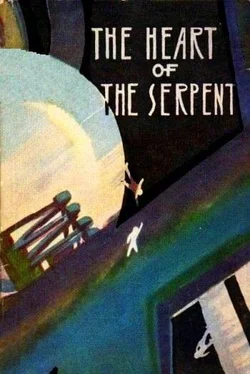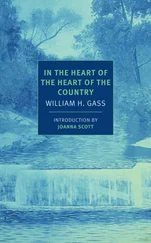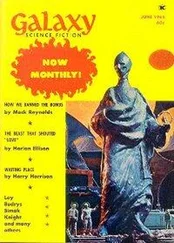Still dazed by their experience, the Earthmen left the communication gallery. The lights went out in the gallery and the outside illumination of the ships was extinguished. The two space ships now hung dark and lifeless side by side in the frigid blackness of space.
Inside, however, work went on at full speed. Here the human brain drew on its inexhaustible reserves of ingenuity to devise new means for conveying to other human beings from a distant planet the knowledge accumulated in the course of thousands of years of labour, perils and suffering — knowledge which had freed man first from the power of primordial nature, then from the shackles of savage social orders, disease and premature old age, and finally opened the way to the boundless expanses of the Universe.
The second meeting in the gallery began with a demonstration of stellar maps. Neither the Earthmen nor the inhabitants of the fluorine planet had ever seen the constellations they had passed on respective courses. (Only later, on Earth, was it established that the fluorine planet’s blue sun was located in a minor stellar cluster in the Milky Way not far from Tau Ophiuchi.) The strangers had been heading for a star cluster on the northern edge of Ophiuchus when they came upon the Tellur at the southern bounds of Hercules.
At the strangers’ end of the gallery a screen made of red metal slats about the height of man was set up. Through the chinks between the slats the Earthmen thought they saw something whirling. Then suddenly the slats turned sideways, disappearing from sight, and before the Earthmen’s gaze there now appeared a vast expanse of space with bright blue spheres spinning in the depths. These were the fluorine planet’s satellites. Gradually the planet itself approached. A wide blue belt of solid cloud circled it at the equator. In the polar and subpolar zones there were glimmers of grey and red, and between these and the equatorial belt there were strips of the purest white like the surface of the strangers’ space ship. Here there was less vapour in the atmosphere and one could faintly make out the contours of seas, continents, and mountain ranges. The planet was bigger than Earth. Its fast rotation created a powerful magnetic field around it. A violet glow extended in long tongues from the equator into the blackness of outer space.
Hour after hour the Earthmen sat in breathless silence before the partition watching the startlingly realistic views of the fluorine planet which the mysterious device brought to them. They saw the violet waves of oceans of hydrofluoric acid washing beaches of black sand, red crags, and the slopes of jagged mountains radiating a cold pale-blue glow.
Toward the poles the blue of the atmosphere grew deeper and the blue light of the violet star around which the planet revolved seemed purer. The mountains here were rounded cupolas, smooth ridges or flat-topped bulges with a bright opalescent glow. A dark-blue twilight had settled in the deep valleys extending from the polar mountains to the scalloped belt of equatorial seas. An opalescent pall of blue clouds hovered over the great gulfs. The shores of the seas were fringed with gigantic structures of red metal and what looked like grass-green stone. Similar structures crept up the longitudinal valleys toward the poles. They must have covered great areas to be visible from such a height. Between the built-up areas there were wide tracts of dense bluish-green vegetation or the rounded cupolas of mountains that had an inner glow like opal or moonstone on Earth. The round ice caps of frigid hydrogen fluoride on the poles gleamed like sapphires.
Blue and violet of all shades were the predominant colours. The very air seemed to be shot through with a bluish radiance. This was a cold, impassive world, as pure, distant and illusory as if reflected in a crystal. A world devoid of the caressing warmth of the multitude of red, orange and yellow colours of Earth.
There were chains of cities in both hemispheres in the areas corresponding to the polar and temperate zones of Earth. The mountains grew more and more jagged and sombre toward the equator. Here sharp peaks jutted up from the seas enveloped in clouds of vapour, and the ranges ran latitudinally, along the fringes of the tropical regions.
Dense masses of blue vapour curled over the tropical zone. Under the heat of the blue star the highly volatile hydrofluoric acid saturated the atmosphere with its vapours, which rolled in vast walls of cloud toward the temperate zones to condense there and pour back into the equatorial belt. Giant dams checked the flow of these mighty streams which were enclosed in aqueducts and tunnels and used to run the planet’s power stations.
Fields of huge crystals of quartz dazzled the eye — evidently silicon took the place of our salt in the hydrofluoric seas.
The screen carried the viewers to the fluorine planet’s cities, sharply outlined in the cold blue light. All of the planet with the exception of the mysterious equatorial zone under its blue shroud of vapour, seemed to be inhabited and bore the imprint of man’s labour and intelligence. Indeed, much more so than Earth, where great untouched tracts under natural preserves, ancient ruins and abandoned workings still remained.
The labour of countless generations and thousands of millions of people reigned supreme over the entire planet, triumphing over the elemental forces of Nature — the turbulent floods and the dense atmosphere shot through with the fierce radiation of the blue star and laden with electrical charges of fantastic power.
The Earthmen could not tear their eyes away from the screen, but as they looked, their imagination conjured up visions of their own planet. But theirs was not the limited vision their forebears in ancient times had had of some particular expanse of field or forest, some rocky, melancholy mountains, or the shores of gleaming seas basking in the warmth of the sun, depending on where they were born or brought up. For the astronauts of the Tellur the world was an entity of frigid, temperate and torrid zones, and their mind’s eye ranged over the splendid panorama of silvery steppes where the wind roamed freely, and the mighty forests of firs and cedars and birches and palms and giant eucalyptuses; the mist-wrapped shores of the northern seas with their moss-covered crags and the white coral reefs nestling in the blue radiance of tropical seas; the cold, dazzling brilliance of snow-capped mountain ranges and the desert aquiver with heat under the blazing sun; the great rivers majectically flowing on to the sea and mountain torrents whipping themselves into foam against their rocky beds; the wealth of colour, the multitude of flowers, the blue sky with its flocks of white clouds, the warmth of sunshine and the chill of a rainy day, the endless kaleidoscope of the seasons. And with all this great richness of nature a still greater diversity of people in all their beauty, with their aspirations, exploits, dreams, sorrows and joys, songs and dances, tears and longings…
The same power of intelligent labour with its ingenuity, skill, imagination and artistry was evident in everything — in dwellings, factories, machines and ships alike.
Perhaps the inhabitants of the fluorine planet in their turn saw with their enormous eyes more than the Earth-men did in the cold blue tones of their planet aivd had progressed farther in remaking their more monotonous nature?
We who were the product of an oxygen atmosphere which is hundreds of thousands of times more common in the Universe had found and would still find an enormous number of planets offering conditions favourable to life as we knew it, and would no doubt also find other living beings like us on other heavenly bodies. But would they be able to do likewise — they who were the product of rare fluorine, with their fluoric proteins and bones, their blood with the blue corpuscles that assimilated fluorine as our red corpuscles assimilated oxygen?
Читать дальше









